Acer Predator Triton 500 review: A truly portable gaming powerhouse with 300Hz G-Sync
- 24 June, 2020 20:00

I’ve tested a lot of gaming laptops over the years, but the newly refreshed Acer Predator Triton 500 is the best one I’ve ever had the pleasure of playing on.
For many years, you could only coax enthusiast-class performance out of mammoth gaming laptops that threatened to throw out your back while you carried them around in your bag. The introduction of Nvidia’s energy-efficient Max-Q technology resulted in more portable play-worthy notebooks, but the truly totable ones usually topped out with graphics options below the upper echelon of performance. Gaming on the go always required some sort of compromise.
No more. The Acer Predator Triton 500 brings it all, pairing a 6-core, 12-thread Intel Core i7-10750H processor with Nvidia’s potent new GeForce RTX 2080 Super graphics chip. All that power somehow squeezes into a sublime 4.6-pound aluminum chassis with a lightning-fast 300Hz G-Sync display that offers drop-dead gorgeous contrast ratios. Is it perfect? Not quite. But hot damn, I love it.
Acer Predator Triton 500 specs and features
 Brad Chacos/IDG
Brad Chacos/IDGAcer sent us the highest-end Triton 500 on offer, loaded with every feature you could ask for. Acer’s site ostensibly lists it for $2,600, but at press time we could only find it available for $2,800 at B&H Photo. You get a lot of hardware for all those pennies.
- CPU: Intel 10th-gen Core i7-10750H
- Memory: 32GB DDR4/3200 in dual-channel mode
- GPU: Nvidia GeForce RTX 2080 Super Max-Q
- Display: 15.6-inch, 300Hz, 1920x1080 IPS screen with Nvidia G-Sync
- Storage: 1TB Samsung NVMe SSD
- Dimensions: 14.1 x 10 x 0.75 inches (without the feet)
- Weight: 4.6 pounds
There’s not much more you could ask for. The included Samsung NVMe SSD blazes along, but if you want even faster speeds, there’s another M.2 slot for expansion, and Acer loaded the laptop with Intel software ready to get a dual-SSD setup humming in RAID 0.
The storage and RAM are difficult to access, however. The Triton 500 uses an inverted motherboard design, which means you’ll need to yank out ribbon cables and the entire motherboard to access the expansion slots. Fortunately, the stock configuration comes with plenty of firepower.
Even the Internet is fast on this beast. The Acer Predator Triton 500 includes Killer’s AX1650 Wi-Fi 6 module and Killer DoubleShot Pro technology. DoubleShot Pro lets the gaming-optimized 2.5 Gigabit ethernet port work together with the notebook’s 802.11ac Wi-Fi, shifting more important tasks to the wired connection and less urgent tasks to the wireless network. The Triton 500 also supports Bluetooth 5.
 Brad Chacos/IDG
Brad Chacos/IDG
Left-edge ports.
Acer included an ample port selection despite this gaming laptop’s relatively small size. The Triton 500 comes with a trio of USB 3.0 ports, Thunderbolt 3, HDMI 2.0, Mini DisplayPort, headset and mic jacks, and the aforementioned ethernet port. It also includes a Kensington lock slot for more security-conscious types.
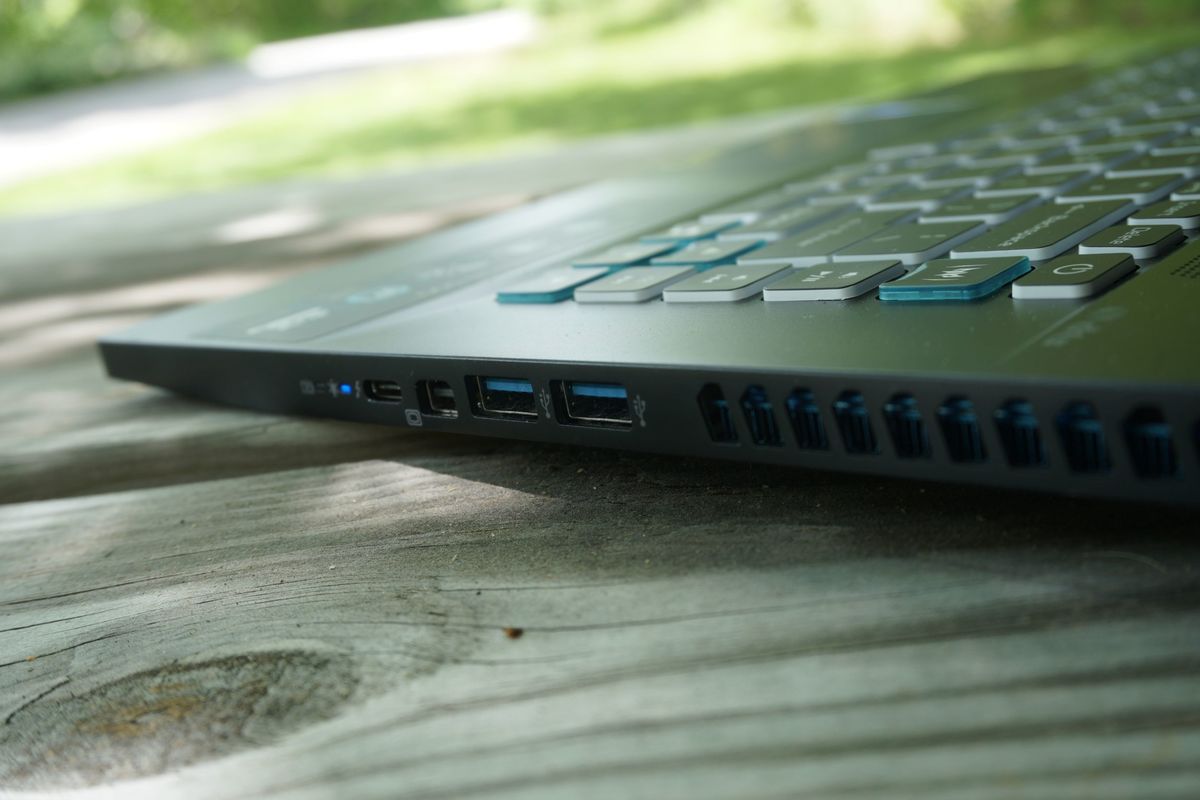 Brad Chacos/IDG
Brad Chacos/IDG
Right-edge ports. Not pictured is a Kensington lock slot at the rear of this side.
Acer Predator Triton 500 design
Most aspects of the Acer Predator Triton 500’s design carry over from last year’s model, and that’s perfectly fine, as this is a wonderfully crafted, fantastically compact laptop. The mere 4.6-pound weight firmly plants the Triton 500 in the thin-and-light gaming territory. Laptops with similar heft tend to offer slower graphics options and other components, driving home just how special this notebook is. This powerhouse feels great tucked under your arm and won’t weigh down your backpack like other monster gaming laptops.
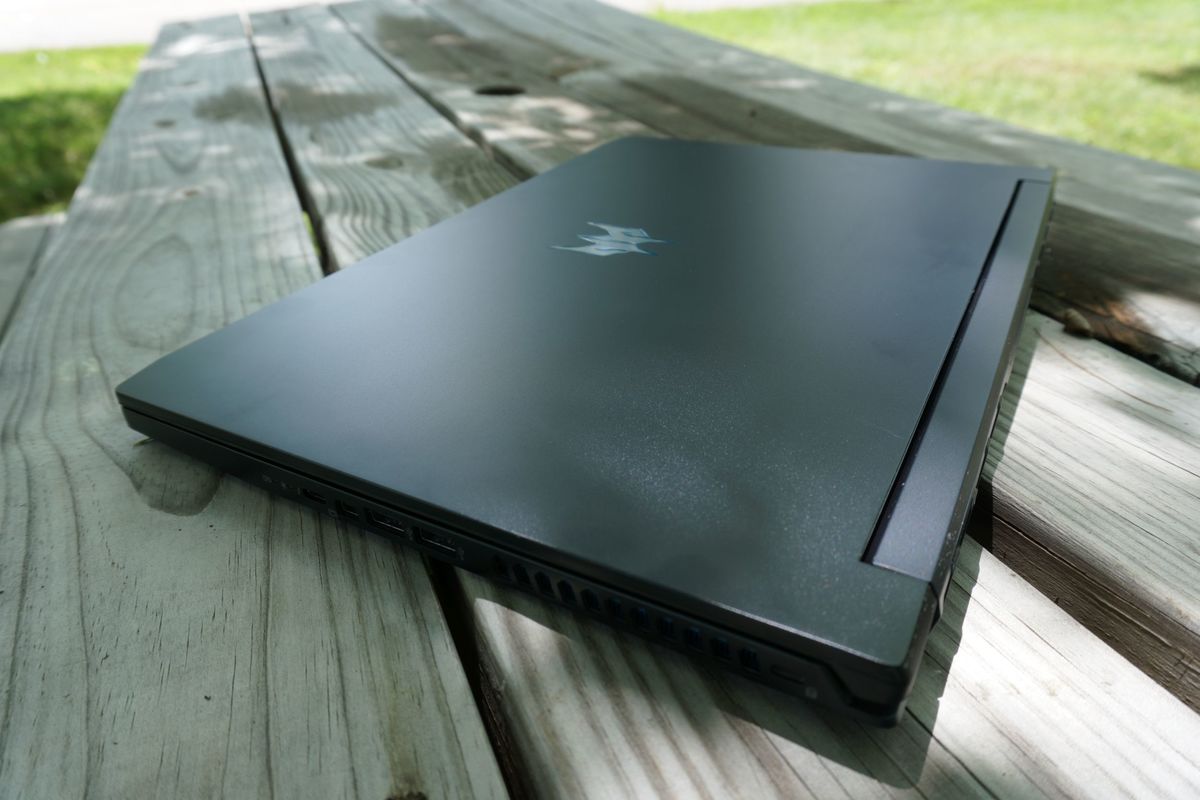 Brad Chacos/IDG
Brad Chacos/IDG
The Acer Predator Triton 500 won’t weigh you down despite the monster hardware inside.
Aesthetics are always subjective, but I adore the sleek, black, aluminum design. There’s no mistaking this for a ho-hum workstation, thanks to the silver Predator logo emblazoned in the middle of the lid (and augmented by a blue backlight). But like Razer’s Blade lineup, the Triton 500 wouldn’t stick out like a sore thumb in an office meeting either. It’s tasteful.
This laptop makes games look great, too. While last year’s model went with a fairly standard 144Hz display, the new Predator Triton 500 delivers an amped-up screen to match the ferocious GeForce RTX 2080 Super Max-Q inside. The 1920x1080 panel—the perfect resolution for a gaming laptop this size, 4K be damned—runs at a ludicrous 300Hz with a rapid 1 millisecond grey-to-grey response time, and better yet, it supports Nvidia’s buttery-smooth G-Sync technology. Playing on this rig is an absolute joy. Hell, just mousing around the desktop feels great. Everything looks super-crisp.
The screen isn’t especially bright, topping out at 275 nits in our test. You’ll want to find a shaded area if you’re using the Triton 500 outside on a sunny day. That said, the image itself looks great for gaming and general use, with spectacular contrast and support for 100 percent of the sRGB spectrum.
 Brad Chacos/IDG
Brad Chacos/IDG
Games look great on the Triton 500
The Triton 500 sounds pretty decent for a laptop too. Acer’s TrueHarmony speakers deliver solid volume and clarity, though like all notebook speakers, they won’t blow away audiophiles. Bass could be deeper, there’s a tendency towards tinnier tones, and the volume won’t impress while the fans are whirring under load. Chuck some gaming headphones into your bag if you can. The laptop comes with DTS:X Ultra surround sound software to make headphone audio more realistic.
We were happy with the Triton 500’s keyboard and touchpad setup last year, and it remains the same this year. Once again, the subtly concave keys feel great under your fingers, and we’re happy that Acer opted for full-size cursor keys rather than the compact monstrosities found on some laptops. Our biggest gripe from the 2019 model has been fixed, too, with Acer now offering customizable backlighting on a per-key basis in the PredatorSense app. Last year, you could only configure the lighting in three large zones.
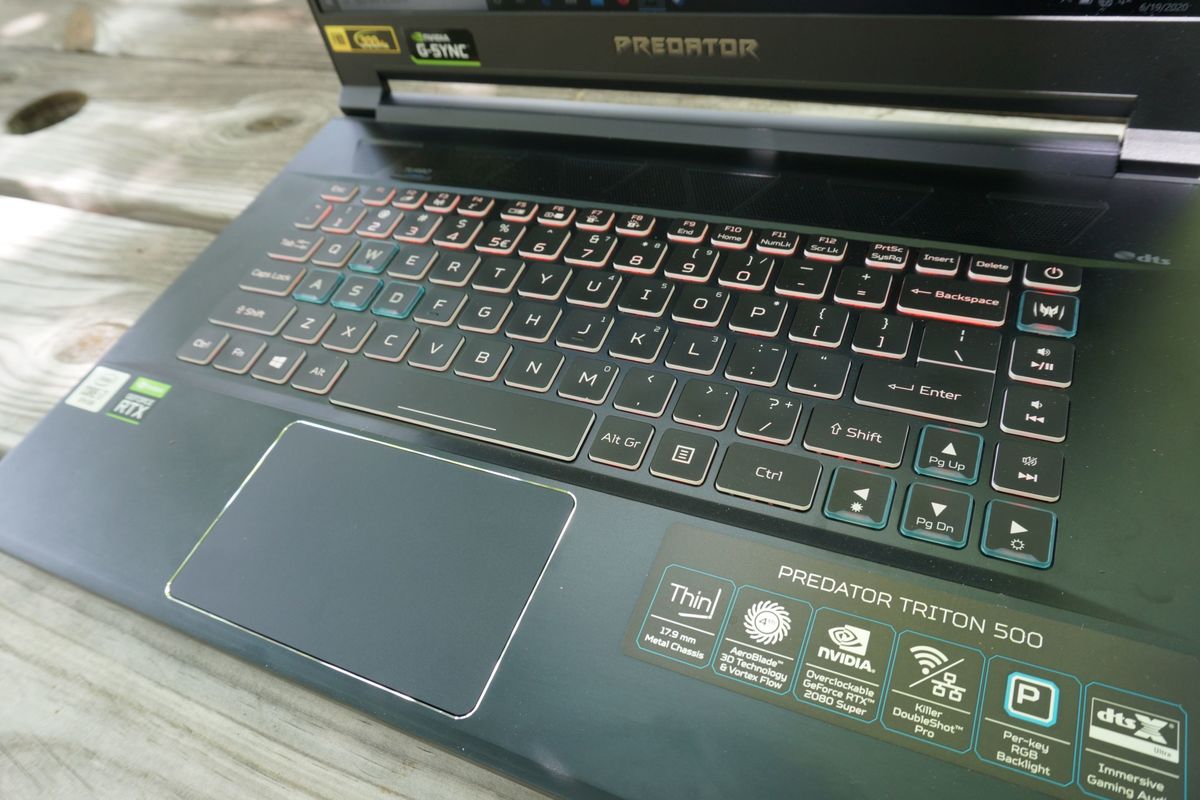 Brad Chacos/IDG
Brad Chacos/IDGThe smooth, comfortable touchpad works like a charm and comes properly centered under the Y key. Too many laptops put their touchpads in bizarre places these days, so it’s great to see Acer stick to the classic placement. While clicks registered just fine, I’d have preferred the addition of discrete mouse buttons at the bottom. Yes, fine, most mobile gamers deploy gaming mice for better control. As a tactics lover, however, I was playing XCOM: Chimera Squad while testing out the Triton, and the only thing keeping it from being a perfect experience sans a discrete mouse was the touchpad’s lack of a right mouse button. Double-pressing the touchpad to right click just doesn’t offer the same accuracy in the heat of the moment and fatigues your fingers during an extended session.
You’ll find (subtle) ventilation ports galore on the edges and bottom of the laptop to exhaust the heat generated by its potent internal hardware. Acer supplements those with Vortex Flow, “a new design involving three custom-engineered fans strategically placed in the chassis, working in tandem to increase additional airflow while also reducing noise.” The company also added five new heat pipes to the Triton 500’s design, along with redesigned fourth-generation AeroBlade3D fans inside that achieve up to 45 percent greater airflow than their predecessors, bolstered by Acer’s CoolBoost technology for increasing fan speeds under load. All told, Acer’s reviewers guide claims the new Triton 500 “gets 33 percent better thermal performance than its 2019 counterpart.”
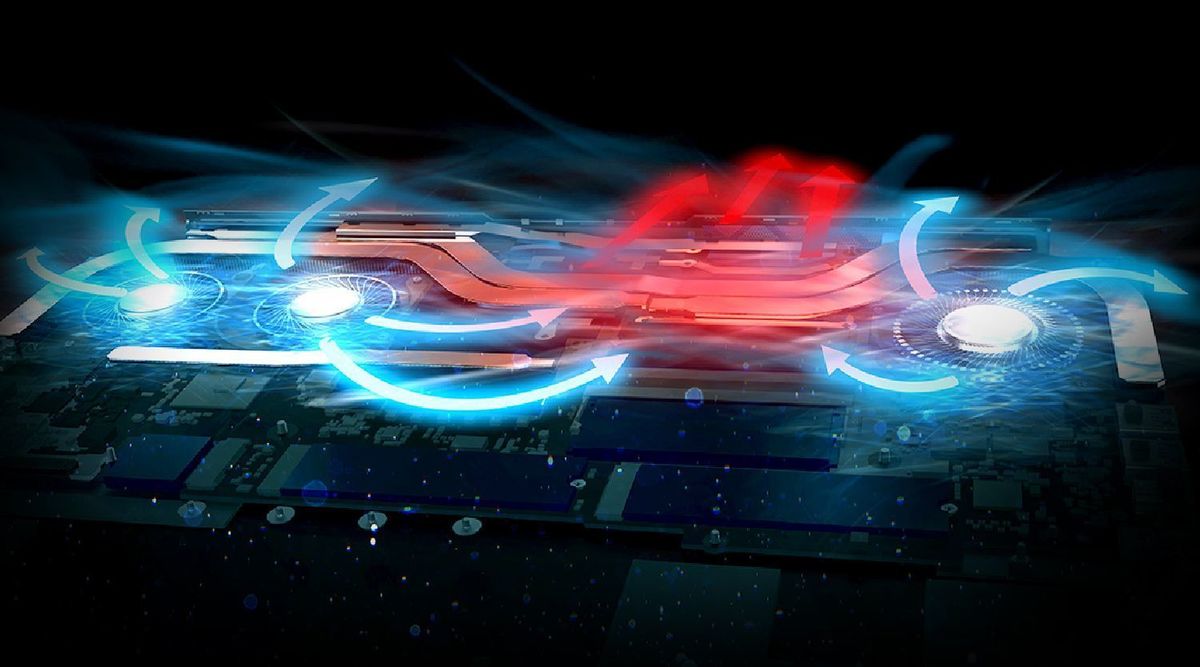 Acer
Acer
An Acer illustration of the triple-fan cooling inside the Predator Triton 500.
The combination does a pretty good job of dissipating the heat spewing from such high-end hardware. The Triton 500 holds up fine on your lap for everyday tasks like email and YouTube videos. If you decide to game from a comfy chair for the hour or so that this laptop can play for when you’re away from a wall socket, the chassis gets warm, but not uncomfortably hot. Likewise, the case fans kick up to a noticeable volume when the laptop’s under load, but it’s not an unpleasant noise. We’re much more bothered when laptop fans sound tinny or high-pitched or oscillating; the Triton 500 gets loud, yet it also fades almost into white noise, especially if you’re using headphones.
Considering that this tiny laptop’s cooling system is taming a six-core Core i7 chip and Nvidia’s most powerful graphics chip, there’s nothing to complain about.
Preinstalled software
The PredatorSense software Acer preinstalls on the Triton 500 serves as your gaming command center, giving you control over RGB lighting, GPU overclocking presets, fan controls, system monitoring, and more. The icons in the upper-right corner offer even more customization options, letting you fine-tune Acer’s TrueHarmony audio for the type of sound you’re listening to and activate features like LCD overdrive and the ability to disable Nvidia’s discrete GPU for better power efficiency when you aren’t gaming. You can only overclock the GPU when plugged in with greater than 40 percent battery life remaining, but it’s worthwhile if you meet those demands. More on that later. (You can also overclock the GPU using a nifty Turbo button over the keyboard.)
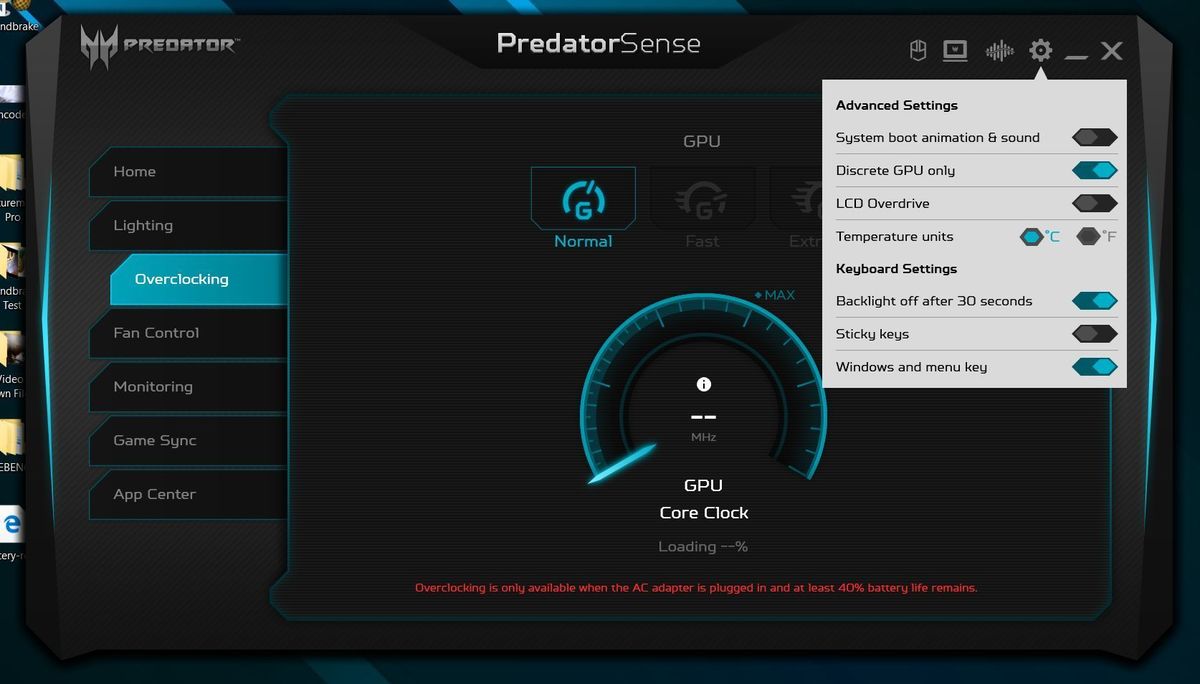 Brad Chacos/IDG
Brad Chacos/IDG
Acer’s PredatorSense app.
DTS and Killer apps help manage your audio and networking, respectively, while Nvidia software and XSplit Gamecaster serve gamers. Acer also loads up the Triton 500 with Netflix, Dropbox, Norton Security Ultra, Firefox, ExpressVPN, CyberLink PhotoDirector, Office, Spotify, and an “Acer Collection S” app with even more. Those are all arguably useful and easily removed, but worth noting when you’re spending $2,600 on a laptop.
Next page: Performance benchmarks and conclusion
Page Break
Acer Predator Triton 500 performance
With Intel’s latest Core i7 flagship and Nvidia’s high-end GeForce RTX 2080 Super Max-Q inside—not to mention the lofty $2,600 price tag—you’d expect the Acer Predator Triton 500 to kick all kinds of ass. Good news: It does. Acer’s design tends to favor the GPU over the CPU compared to some rival laptops—but that’s a smart strategy in a notebook designed first and foremost for high-speed gaming.
We’re comparing Acer’s svelte powerhouse against similar systems that prioritize portability. We test each system while plugged in, using the default settings set by the manufacturer. For the Triton 500, Acer uses the middle-of-the-road “better battery” setting, rather than cranking up the full performance option.
The dual-screen HP Omen X 2XS isn’t as tiny as the others, but it’s powered by the direct predecessors of the CPU and GPU hardware inside the Triton. The 5.5-pound Gigabyte Aero 17 comes with a more powerful Core i7-10875H processor, but less powerful GeForce RTX 2070 Super Max-Q graphics. Meanwhile, the 4.6-pound MSI GS66 Stealth pairs the RTX 2080 Super Max-Q with Intel’s beefy Core i9-10980HK.
We also included the Asus ROG Zephyrus G14, which comes packing an AMD Ryzen 9 4900HS processor and Nvidia’s GeForce RTX 2060 Max-Q. It’s underpowered compared to the other systems, and costs much less at just $1,450, but it also weighs a lot less, tipping the scales at a mere 3.5 pounds. That’s unheard-of in laptops with Intel CPUs, and we wanted to include results here in case portability is your priority.
This is a gaming laptop, so let’s start with graphics performance. Spoiler: The Acer Predator Triton 500 and its GeForce RTX 2080 Super Max-Q tops the charts.
 Brad Chacos/IDG
Brad Chacos/IDGUnlike desktop components, all laptop performance comes as part of a tightly integrated system, so we record the Overall score in 3DMark’s Fire Strike Extreme, a DirectX 11 benchmark, rather than dialing in specifically on the graphics score.
The Acer Predator Triton 500 blows away all comers here, including the MSI GS66, which ostensibly includes the same GeForce RTX 2080 Super Max-Q graphics chip and a more potent Core i9 processor. Yet the Triton easily surpasses its performance—a trend we’ll continue to see throughout the gaming benchmarks.
What gives? The MSI GS66 weighs the same as the Predator Triton 500. Cramming a faster, hotter Core i9 into such a small gaming laptop causes it to throttle more easily, much like the notorious Core i9-equipped MacBook Pro. Either way, the Triton 500 leads the pack.
 Brad Chacos/IDG
Brad Chacos/IDG Brad Chacos/IDG
Brad Chacos/IDGWe standardize our laptop testing around a pair of older games, Rise of the Tomb Raider and Middle-earth: Shadow of Mordor. Using established games lets us compare performance across multiple laptop generations and reduces the odds of a game update drastically altering performance and invalidating past results. We test at 1080p resolution with maxed-out graphics settings.
The Triton 500 once again sprints far ahead of the pack here, including the MSI GS66 with an identical graphics chip. It also leaves the HP Omen X 2XS, equipped with older versions of similar hardware, in the dust. No other portable gaming laptop clears 150 frames per second in Shadow of Mordor; the Triton 500 hits 184. Acer’s design gives the Nvidia chip inside plenty of room to run.
 Brad Chacos/IDG
Brad Chacos/IDGThat’s not even in the Triton 500’s ultimate form. Acer defaults to using Windows 10’s “better battery” mode rather than “best performance,” and its PredatorSense app includes preset GPU overclocking options. Turning on both results in a noticeable gaming upgrade, so if you’re connected to a wall socket, do it! Be aware that cranking up performance also means cranking up the fan noise, however. Again: Bring a gaming headset.
The chart above shows performance results for the Triton 500 in stock and maximum-overclocked modes. We also included results for Shadow of the Tomb Raider in DirectX 12 and Strange Brigade running Vulkan, so you can see how the laptop performs in newer titles that use closer-to-the-metal gaming APIs.
 Brad Chacos/IDG
Brad Chacos/IDG Brad Chacos/IDG
Brad Chacos/IDGWe’ll kick off the more CPU-focused testing with Maxon’s Cinebench R15. It’s a standalone benchmark that measures CPU performance while rendering a 3D image. It’s a good way to gauge multi-core performance, especially in a potent notebook like this. Helpfully, Cinebench can also test single-threaded performance. (Maxon recently launched Cinebench R20 with a longer rendering scene. We also tested that and saw similar results.)
The Acer Predator Triton 500 lands pretty much where you’d expect. The 6-core, 12-thread Core i7-8750H inside isn’t quite as speedy as the faster 8-core chips inside the MSI GS66 or Gigabyte Aero 117, but it’s a good chunk faster than its predecessor in the HP Omen laptop. It hangs tough in single-threaded performance too, which most games favor. This is a fast, capable CPU that won’t hold you back.
Look at how that 8-core Ryzen chip inside the ROG Zephyrus G14 rips through multi-core rendering, though—hot damn. It’s also interesting to see the MSI GS66’s Core i9 chip lag behind the Core i7 inside the Aero 17 at single-threaded performance, further indication that cooling is an issue with that laptop.
 Brad Chacos/IDG
Brad Chacos/IDGCinebench’s biggest drawback is its short run time. Because modern CPUs rely on boosting clock speeds for short periods, a benchmark that’s too brief doesn’t tell you how a laptop might run on a lengthy all-core load. To test that, we use the free HandBrake encoder to convert a 30GB movie file using the Android tablet preset.
HandBrake loves more cores, so it’s no surprise to see the 8-core systems finish the task several minutes before the 6-core Core i7-10950H in the Triton 500. That said, the 10th-gen chip wraps up over five minutes faster than its 9th-gen predecessor in the HP Omen, crossing the finish line after just shy of 29 minutes. For even more context, on most quad-core systems, you’re looking at 50 minutes of running the CPU hard to complete this benchmark.
 Brad Chacos/IDG
Brad Chacos/IDGNow for the lone bit of bad news. All the power inside the Triton 500 and the introduction of a buttery-smooth G-Sync panel comes at a price: battery life. For our test, we loop a 4K video file using Windows 10’s Movies & TV app. We set up the laptop as if it were playing a movie on a cross-country flight. We put it into airplane mode and attach earbuds with the volume set to its midpoint. We set the screen brightness to 250 to 260 nits, which is a comfortably bright setting for an office or airplane’s daylight settings.
Using the laptop’s default settings—“better battery” in Windows 10, and the Nvidia GPU always on—Acer’s laptop gives up the ghost before it even hits the four-hour mark in our video rundown test. That’s disappointing, full stop, and especially in a portable laptop built for going on the road. The HP Omen died sooner, but only because it packs dual screens rather than the usual one. This is the Triton 500’s Achilles heel.
The laptop still held up well for intermittent general task use throughout the day—checking email, watching YouTube videos, web browsing or whatnot. And if you open Acer’s PredatorSense app and click the gear/cog icon in the upper-right corner, you’ll see a “discrete GPU only” option enabled by default.
 Brad Chacos/IDG
Brad Chacos/IDGDisabling it lets the integrated graphics chip inside the Intel CPU take over basic rendering functions, which helps extend battery life when you aren’t gaming, albeit at the cost of G-Sync. Flipping the GPU option off and on requires a reboot, but the ultra-fast NVMe SSD inside will have you up and running again in under 15 seconds. It’s worthwhile. Just be sure to enable the feature before you game to let Nvidia’s GPU and G-Sync capabilities work as intended.
Either way, don’t leave home without your power cord. That’s standard with any gaming laptop, and a necessity with this one.
Should you buy the Acer Predator Triton 500?
 Brad Chacos/IDG
Brad Chacos/IDGThe Acer Predator Triton 500 impresses me more than any other laptop I’ve touched. It’s incredibly portable, more powerful than any lightweight rivals, and looks gorgeous. The high-contrast 300Hz G-Sync screen makes any game buttery-smooth. The Core i7-10750H pairs perfectly with Nvidia’s high-performance GeForce RTX 2080 Super Max-Q for gaming. Acer also loaded this notebook with everything you could ask for, including plenty of ports and wireless connectivity.
Is it perfect? No. The battery life disappoints, a damned shame in such a portable gaming laptop. The fans—though relatively pleasant-sounding—can get loud under gaming loads.
Don’t let those quibbles deter you, however, especially if (like you should be) you’re always plugged in while you game. Slight compromises like that are required to squeeze this much firepower into a chassis this small. The Acer Predator Triton 500 proves that you can get desktop-class gaming performance in a truly lightweight design. Few laptops manage to pull off what this one’s achieved. Highly, highly recommended if you can afford it.
 Brad Chacos/IDG
Brad Chacos/IDG




